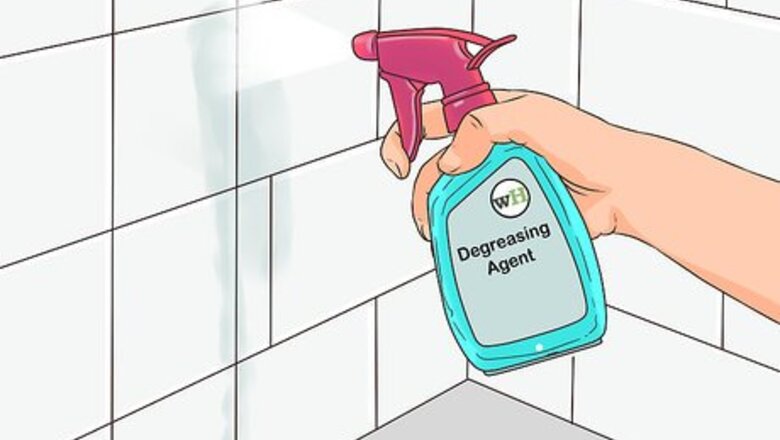
views
Cleaning Soap Scum Properly
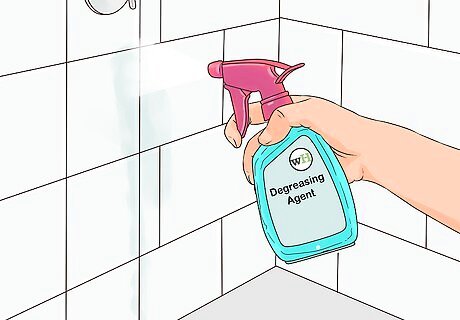
Apply a degreasing agent if your surface is tile, acrylic, or fiberglass. Choose a store-bought degreasing agent to remove existing soap scum. If your cleaning product has a spray bottle, you can pull the trigger to squirt it directly onto your shower walls. If your product has a pour cap instead, you can squeeze 2-5 dollops onto your rag or sponge, and wipe it across all your surfaces. You want an even, thin layer to cover each surface with soap scum. Purchase chemical cleaning products safe for bathrooms at most home supply or janitorial supply stores.

Use a non-acidic cleaner if you are cleaning natural stone tile. If you have tiles made out of marble, slate, granite, or Travertine, it is best to use a cleaner that is gentle on these surfaces. You should also avoid using rough, abrasive scouring pads. Apply the gentle cleaner to the scummy areas with a soft kitchen sponge. Using harsh chemicals can damage your tile or result in discoloration. You can purchase this at most home supply or janitorial supply stores.
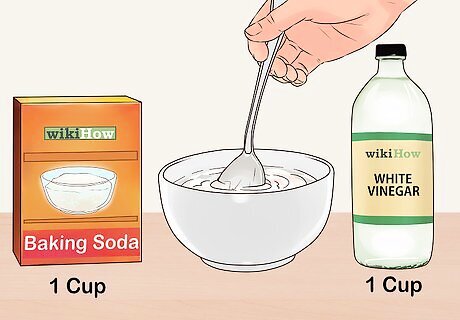
Mix baking soda and vinegar if you want to use a natural cleaner. Measure 1 cup (236.60 g) of baking soda and pour it into a small bowl. Slowly add vinegar about 1/2 cup (118.30 g) at a time until you have a paste-like substance. Apply the mixture to your surfaces once it stops fizzing using a rag or sponge. The amount of vinegar you use will vary based on the consistency of your mix, though it should be about 1–2 cups (240–470 mL). If you don't have baking soda, you can also combine equal amounts of vinegar and water in a spray bottle, and squeeze in 1 US tbsp (15 mL) of dish detergent. Spray the mixture on your soap scum when you are ready to clean.
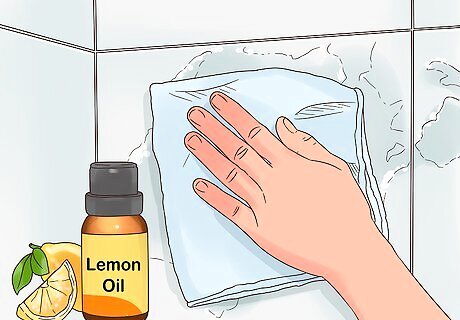
Apply lemon oil to prevent soap scum from coming back. Place about 1-3 drops of organic lemon oil on a clean, dry washcloth, and rub the oil over the scummy areas. Over time, regularly using lemon oil will decrease the time it takes to clean your surfaces.
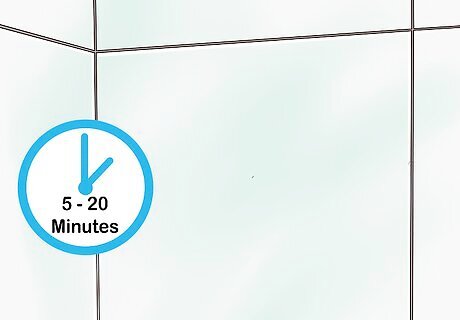
Let your cleaning product sit for 5-20 minutes. Different products will have varying instructions regarding how long to let each product sit. Because of this, you want to read over the label after you apply the cleaning agent. Set a timer for the indicated length, so you know when to clean the product away. Not every product requires time to sit. If your label does not mention sitting time, you can clean it away immediately.
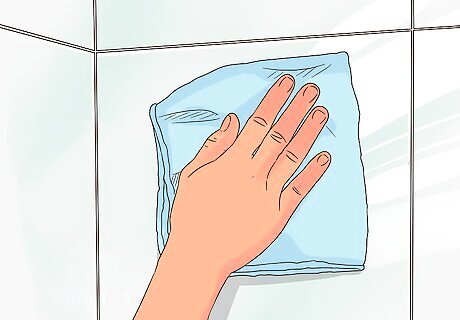
Wipe or scrub the cleaning agent with a soft rag until the scum is gone. Once your cleaner has dissolved the scum, take a clean rag or sponge, and scrub the area in a circular motion. Do this over the entirety of your surfaces, starting at the top. It may take several minutes for your soap scum to lift up, so have some patience and flex your muscles! It is helpful to start at the top so you don’t have to clean your surfaces again after you wipe them down. Avoid using an abrasive scouring pad to prevent scratching the surface.
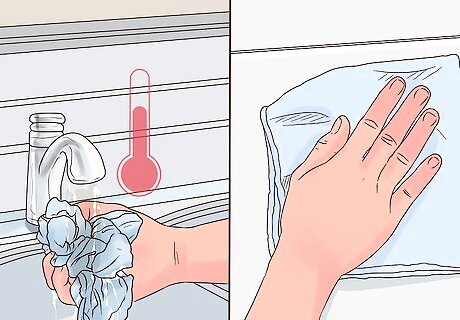
Rinse away the soap scum and cleaning agent with warm water. Once your surfaces are free of soap scum, turn on your faucet, dip a clean rag or sponge into the running water, and wipe down the area.
Avoiding Scum in the Future

Switch to using a liquid or gel soap instead of cleaning with bar soap. Soap scum is a direct result of using bar soap, so an easy way to prevent soap scum is to use a different soap. Choose from liquid cleaners such as Castile soap, or go with gel body washes and body scrubs. Using these products should drastically cut down on the amount of soap scum. Most of these also smell fantastic! Both liquid and gel soaps clean just as well as bar soap. EXPERT TIP Ashley Matuska Ashley Matuska Professional Cleaner Ashley Matuska is a Professional Cleaner at the Founder and Owner of Dashing Maids in Denver, Colorado. Ashley has over seven years of experience in the cleaning industry. She and her team specialize in offering sustainable deep cleaning and maintenance cleaning services. Ashley Matuska Ashley Matuska Professional Cleaner Bar soaps create a film in your shower. Ashley Matuska of Dashing Maids says: "Bar soaps are made from a really thick material that builds up in your shower. Most soaps and products that come in bottles are more soluble, so they'll get down the drain a little quicker than bars of soap."
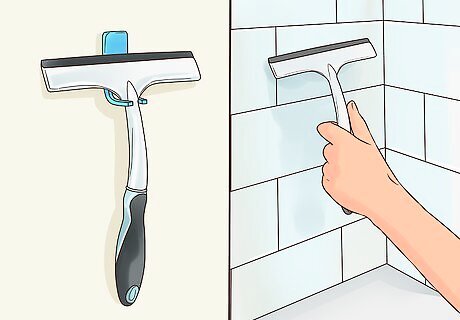
Keep a squeegee in your bathroom and use it after each shower. Buy a squeegee so you can remove excess moisture and soap residue. Place 1 in your shower or next to your tub. Squeegee every wall from top to bottom when you get out of the shower. Press hard enough to remove the water from the surface. It is best to use hand squeegees with a blade about 6–9 inches (15–23 cm), so you can easily get into corners. If you aren’t able to squeegee your shower after each use, aim for at least every 2-4 times you shower.
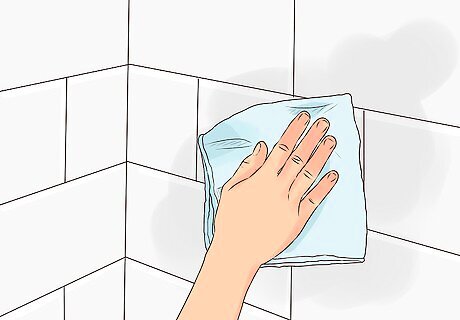
Wipe your surfaces with a clean rag to get rid of excess moisture. Place a rag next to your shower, tub, or sink so you can easily access it. After using the sink, shower, or tub, wipe away any remaining water droplets or bubbles from the surface. You can do this after you squeegee your shower.
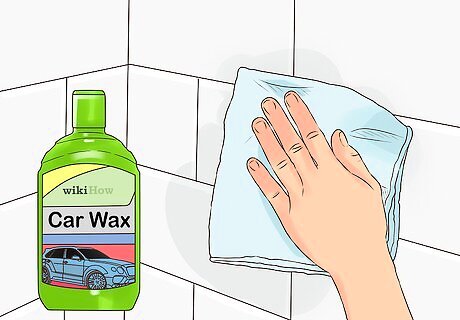
Apply car wax with a rag to your surfaces to keep away soap scum. Take a clean, dry rag, and squeeze or scoop up a dollop of wax about the size of a quarter. Spread this around in your rag, and rub it in a circular motion over your surfaces. Reapply the wax to your rag as you run out. Aim to have a smooth, even layer of wax over all of your surfaces. Avoid applying car wax to the floor of your shower or tub. This will make the surface too slippery! Leave the wax on the surface, and reapply it when your water stops beading up. There is no need to remove it.

Add Epsom salt to your bathwater to minimize soap scum build-up. When you take a bath, pour about 1 cup (236.60 g) of Epsom salt into the warm water, and mix it up with your hands. Not only does it soothe your sore muscles, it also softens your water and decreases soap scum build-up. You can purchase Epsom salt at most drug stores and department stores.

Spot-clean soap scum with a dryer sheet. Wet the surface with a damp cloth and place 1 dryer sheet flat against your palm. Rub the dryer sheet across the surface in wide, circular motions. Then, wipe your surfaces with a clean, damp washcloth. You can easily wipe away any water stains or shadowy residue from your shower doors and walls.
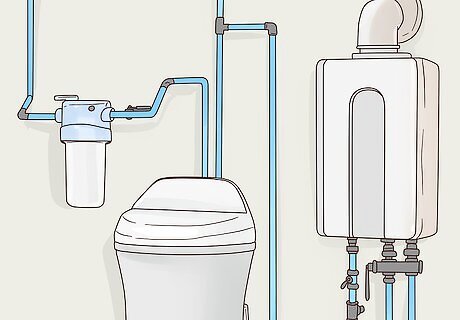
Soften your water if all else fails. If you still have a lot of soap scum build-up after trying preventative measures, try installing a water softener. A water softener remove minerals that react with your soap and cause soap scum. You can purchase one at most home supply stores or online. If you don't want to have it professionally installed, follow an online tutorial to learn how to install it. These use tiny resin beads, which attract and remove the calcium and magnesium in your water. These minerals build up in the form of soap scum. Water softeners are powered by water flow, which is great because it will not add to your electric bill.




















Comments
0 comment